NOT TOO SHABBY FOR US, EITHER
iView MediaPro -- What the Pros Use
 By MIKE PASINI
By MIKE PASINIEditor
The Imaging Resource Digital Photography Newsletter
Sometimes you need a second opinion. In the midst of our review of MediaPro, iView Multimedia's asset manager (and a little bit more), we asked our better half Joyce to take a look at a catalog of over 12,200 images we've collected since 1993 in PhotoCD and JPEG formats.
"Wow, this is cool!" she confirmed.
What she especially liked was being able to scan through legible thumbnails of every one of our images not on film. "I forgot we had some of these," she confessed.
|
C O N T E N T S |
The nice thing was that we just had to burn a CD with our 64-MB catalog and the free iView Catalog Player (for Mac or Windows, or both) to share this treasure. The competent Player also let her search for Thanksgiving images or Scrapbook pictures or any Exif field she might have wanted (like the capture date). And all without keywording, since the Player, like MediaPro, can search on the original image's path name -- and our path names always include the date and a descriptive slug.
Turns out this is just the tip of the iceberg, but that is where you plant the flag.
WHO ARE THESE GUYS? | Back to Contents
Based in London, iView Multimedia (http://www.iview-multimedia.com) was founded in 1996 by Yan Calotychos. He developed the software to manage the scan, translation subtitles and voice recordings he juggled in his day job producing multimedia CD-ROMs (remember those?).
He quit his day job.
iView got its bearings as Macintosh freeware, grew into a shareware product and propagated itself by being bundled with Roxio's Toast and Nikon's digicams. Recently, it ventured into new territory with its first Windows release.
We used some of those early versions (when we had just a few hundred images, most of which we wanted to forget we took) and have been studying MediaPro since version 2.x was released.
In addition to its $199 MediaPro and free Catalog Reader, the company also offers the capable $49.99 Media asset manager, limited to formats other than Raw and catalogs to 8,000 entries. See http://www.iview-multimedia.com/products/compare.php for a comparison with Media Pro.
IN PERSPECTIVE | Back to Contents
To be imperfectly honest, it's hard to place MediaPro. On the one hand, programs like iPhoto and Adobe Photoshop Album do an admirable job of handling the organizing and sharing demands of the average user. On the other, not even the 16-cylinder asset manager Canto Cumulus quite does what MediaPro can do.
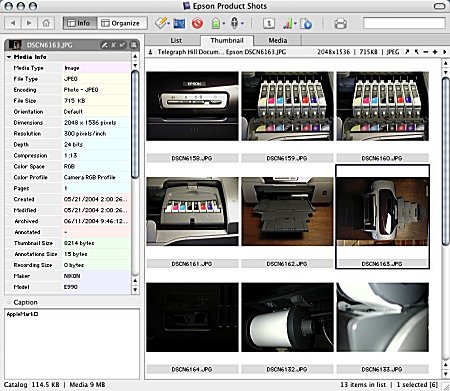 |
| The Macintosh Version Thumbnail View |
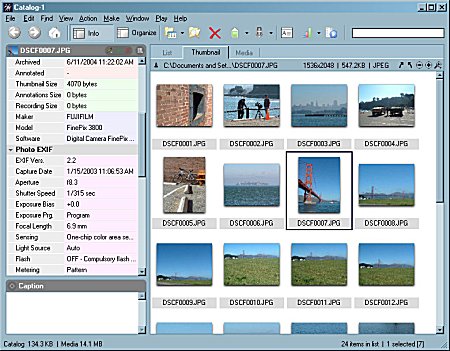 |
| The Windows Version Thumbnail View |
Among asset managers, we've reviewed Cumulus, QPict and Extensis Portfolio. It seems as if we had to learn German to use Cumulus and, while we have fond memories of Portfolio (especially its ability to keyword on import), it's been broken a long time for OS X users. We look forward to reviewing version 7, but the delay is distressing. QPict, on the other hand, has only one fault. It isn't cross platform.
You might think we're being picky. But then there's MediaPro (see our illustrated review at http://www.imaging-resource.com/SOFT/IVM/IVM.HTM).
As Apple moved the target, iView refocused its sight. It is, hands-down, the most actively developed asset manager available. And now it is not only cross-platform, but its free catalog readers (which also play perfectly serviceable slide shows) are available for both Macintosh and Windows. We've long sought a simple cross-platform slide show viewer we could burn on the CDs of our images we leave behind with hosts, friends and family.
But as we used MediaPro, we came to appreciate its design hallmarks:
- Ease of use, first of all. It looks good and works simply. Just drag a PhotoCD or folder of JPEGs into the view panel and they're cataloged. Just as you'd expect. You can get fancier (cataloging when a camera is attached or watching a folder for new files), but simple works fine, too.
- Customization, second. There's little you can't do your way. We wanted those Portfolio keywords generated from path names, even though MediaPro can search on words in the path name of the original file. No problem. An AppleScript will parse the path name into keywords, too. There's even a custom file info panel for Adobe Creative Suite to edit four otherwise unsupported IPTC annotations. But this goes further, with Helper applications (which can even be Photoshop Droplets) to do things the program doesn't.
- Versatility. It starts with the cross-platform nature of the new release but extends to its disc archiving and Web album features (which, yes, you can customize).
- Responsiveness. No, it isn't perfect. But its active development indicates it's trying -- and without an axe to grind. You won't find a Windows player for your iPhoto albums (or a Mac player for your Album catalogs), but MediaPro just wants what you want.
SYSTEM REQUIREMENTS | Back to Contents
MediaPro on Macintosh requires a PowerPC, OS 9.1 or OS X, CarbonLib 1.5, QuickTime 6, 8-MB RAM on OS 9 and 13M free disk space. On Windows, it requires a Pentium class processor, Windows 98/ME/200/XP, DirectX 7.0, QuickTime 6, Internet Explorer 5.5, 128-MB RAM and 12-MB free disk space.
NEW IN 2.5 | Back to Contents
Since it's been around so long, a rundown of the features new to version 2.5 might be helpful. If you're new to the program, skip ahead.
User interface improvements include redesigned toolbar icons, Safari-style tabs on the Mac version, state navigation (like your Browser's back button) in the Organize Panel, which itself can be configured.
Support for Adobe's Extensible Metadata Platform standard means the program can now read and write XMP annotations. XMP fields are mapped to MediaPro fields so files annotated in Photoshop 6 using IPTC fields and files annotated in Photoshop CS using XMP data would appear correctly annotated in MediaPro. Catalogs can also be exported as XML data files.
The Organize Panel has been reorganized into a Catalog Index (the old Field Finder), with Color Labels and Catalog Sets. The Folders Panel has been renamed Catalog Folders as part of the Organize Panel.
You can customize Color Label names and colors.
File format support now includes Kodak SLRn and SLRc digicams and improved PDF/EPS support.
Built-in JPEG compression of thumbnails reduces catalog size over 50 percent compared to MediaPro 1.5.
INSTALLATION & UPDATES | Back to Contents
Installation was state of the art. On both Macintosh OS X and Windows XP, a double click took care of everything, without disturbing anything. U.S. English, French, German and Japanese language support is tailored to the default language of your operating system (or the last language used).
To complete installation, we entered our license number in the License menu.
In addition to the PDF manual available online, iView offers additional resources on its Web site, including tutorials, customer support, forums and updates retrievable from a Check for Updates menu command. Did we say state of the art?
WORKING WITH MEDIAPRO | Back to Contents
MediaPro creates a catalog file, which can grow quite large, that is simply a database of your asset collection. Each record represents one file somewhere and may include the size of the file, the dimensions, a thumbnail, keywords, all sorts of data. You can even add up to 16 custom fields of your own.
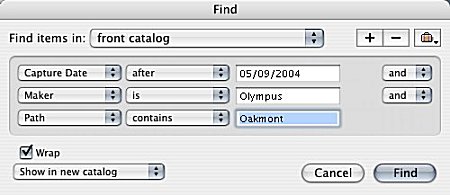 |
| The Find Dialog Multiple options in each popup menu |
Assets may be image files, sound files, HTML files, movies, anything. MediaPro understands 70 basic file formats and over 50 advanced file formats (Raw, PDF, fonts, etc.). The Windows version, missing JPEG 2000 support, lags a bit behind the Mac in format support.
"It would be nice," Joyce elbowed us, "if these thumbnails were a little larger." Indeed, they might have been. We used the default 96x96 pixel size, assuming iView knew more about it than we did. It's a quite serviceable size, easily identifiable. But if we realized we were going to distribute the 64-MB catalog, we might have made them twice as big, even three times larger. MediaPro can make thumbnails up to 640x640, which is the resolution digicams bragged about in 1998.
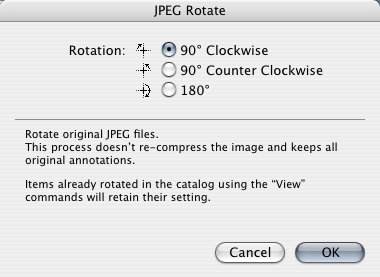 |
| Rotating a JPEG Corrects the orientation of original image, too |
Thumbnails are a world of their own. Image editors are fond of embedding them. Digicams can hardly resist. And MediaPro is happy to pick them up or render its own (which, it notes, are better and smaller). You even have your choice of resampling methods (nearest neighbor, bilinear and bicubic).
That's about the only decision you have to make. There's no need to configure a catalog (although you certainly may, adding a description, a password, encryption and file locking).
With the design work out of the way, you're ready to get to work.
THE WORKSPACE | Back to Contents
MediaPro's working window includes a menu bar, a toolbar below it, the Info and Organize Panels on the left and the Viewing Area on the right. The Panel dividers can be dragged to adjust their width and height.
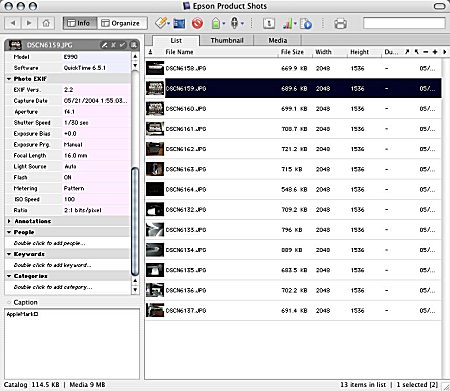 |
| List View |
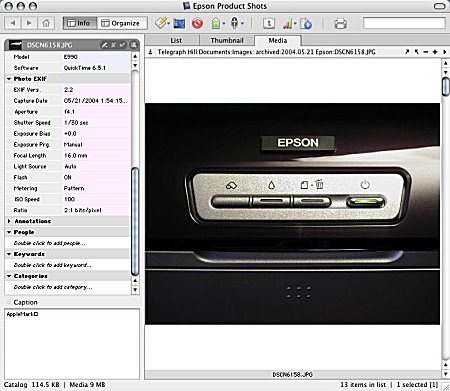 |
| Media View |
The Viewing Area can display three different views: List, Thumbnail and Media.
- List view presents a typical database view of the catalog, one record per line, one column per field (you select which fields). You can sort on a field by clicking on its header (which is how we learned the range of f-stops and EV settings we've used over the years). The first field displays a thumbnail, which may even be a playable movie or audio file.
- Thumbnail view presents the familiar light box layout of images, which can be enhanced with drop shadows and borders. You can rotate thumbnails in batches but a separate command is used to perform lossless JPEG rotation. Rotated thumbnails do correct orientation for how MediaPro displays the images in slide shows and HTML galleries, though. You can select any frame in a movie as the thumbnail image just by playing the movie to that frame and using the Rebuild Item command on the Action menu.
- Media view presents one original file at a time, full size and in real-time. You can watch movies, page through PDFs, listen to audio files and zoom into images if the original is accessible.
IMPORTING | Back to Contents
Our sample catalog was built by dragging one CD after another into the Viewing Area. It took about an hour, much of which we spent admiring ourselves in the shiny reflective surface of the discs.
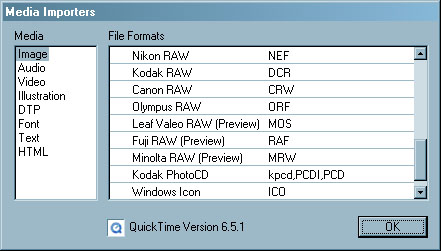 |
| Media Importers Just a few of the many supported formats |
But MediaPro is just as happy to download images from your cabled camera or inserted flash card. It will even delete them from the card, if you ignore our advice to only use the camera to delete.
Or you can tell MediaPro to watch a particular folder and, when new images show up, catalog them.
FILE INFORMATION | Back to Contents
We were content with having a thumbnail of every digital image in the house. For about 10 minutes. Then we wanted to see certain collections. A graduation, a Thanksgiving, a Christmas, the gang at the rehab clinic, you know.
In addition to the thumbnail and location of the original file, the catalog stores information relevant to the type of file it is and tags to organize it. It picks up the embedded file info (a.k.a. metadata) on import but you can add tags afterwards. The Info Panel displays all this at a glance, with expandable main headings for Media Info, Photo Exif/Cue Points/Movie Tracks, Annotations, Keywords and more.
Annotations are actually the 19 pre-defined International Press and Telecommunications Council fields, which Adobe has rolled into its XMP standard. MediaPro can read XMP metadata in JPEGs, TIFFs, PNGs and native Photoshop files.
While the IPTC specification includes a copyright field, it's not the same one used by Photoshop to mark the filename in the title bar when you open the image. Adobe also uses a custom flag to tell whether an image is copyrighted or not. This proprietary copyright data is aggravating, to put it mildly. We see no way to add it outside Photoshop. And using the IPTC field makes no impression on Photoshop.
But just a minute. Where are these annotations stored? What good is copyright information stored in a catalog file? How about writing it to the copyrighted file?
Well, you can do that if you synchronize catalog items with their originals. When you sync annotations using the Action menu, IPTC, QuickTime and XMP metadata are written to and imported from the original file. So you can batch annotate your catalog, then let MediaPro update your originals without having to open and close each file.
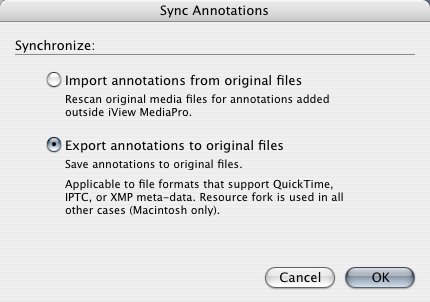 |
| Sync Annotations Work with the Catalog and Originals |
Fortunately, you can Auto Fill annotations by filling one out (say, your copyright) and saving it as an Auto Fill using a drop down menu in the Info Panel. Then just select the records to apply it to and use the drop down menu to pick the Auto Fill. An auto-completion feature is also available to finish typing city, state and country names, for example.
The information cribbed from metadata is extensive enough to obviate the need for much keywording. Annotation of copyright is a bright idea, but the field is problematic. Still, MediaPro makes this an easy job. Portfolio makes it a touch easier, but not much.
FOLDER MANAGEMENT | Back to Contents
MediaPro's Folder Panel lists the folders containing your cataloged images. You can click on a folder to see what it contains in the Viewing Area. If you use our patented folder naming convention of date and event, this can be a quick way to find a set of photos.
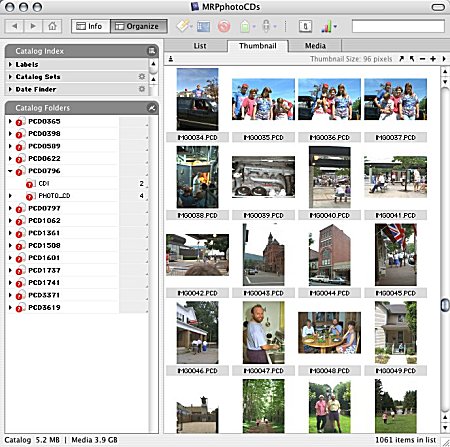 |
| Organize Panel Note the PhotoCD list in Catalog Folder pane |
But you can also manage your folders from the Folder Panel, opening, moving or revealing both files and folders, renaming and batch renaming files, resetting or updating paths, creating or renaming folders and deleting either the catalog reference or the original.
MAKE | Back to Contents
One of the more interesting Menu options is Make. From this menu, you can run a Slide Show, burn a backup CD, create an HTML gallery or contact sheet and do various format conversions and metadata extractions. Let's look at the two most exciting.
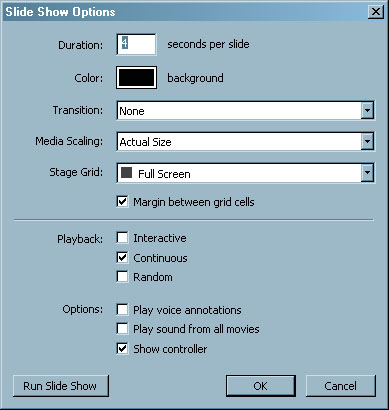 |
| Slide Show Options There's a nice selection of transitions |
Slide shows (also available in the free Reader) really don't require any attention -- but they do need access to the originals. Which wasn't feasible with our 12,200+ image catalog. Still, when we copy images off a card to our hard disk, we drag the new folder into the Viewing Area to use the JPEG rotation action to correctly orient them and then we run a slide show. A very nice slide show with cross fades to a black background. Which can be saved as a QuickTime movie.
Creating a Web gallery is just as easy, providing eight different themes (plus any you create yourself). This popular option is well implemented (we used it for our last Seybold report). It's a great way to use the free disk space allocated to your account by your Internet service provider. You probably have 10-MB sitting around doing nothing. Just upload a Web gallery and send the URL to all your accomplices.
IMAGE EDITING | Back to Contents
We like to linger over our image editing, performing feats of magic and undoing them at will. But for those images that need just a quick and routine fix, MediaPro provides a number of tools.
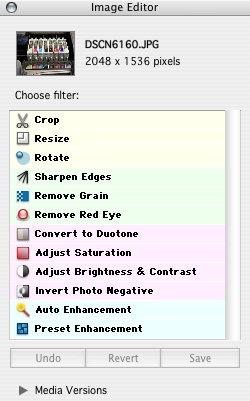 |
| The Image Editor Just pick a task ... |
In the Media tab of the Viewing Area, display any image in the catalog whose original is within reach (not archived offline) and click on the Image Editing tool. A small window pops up with a thumbnail and list of tools. You can crop, resize, rotate, sharpen edges, remove grain, remove red eye, convert to duotone, adjust saturation, adjust brightness, invert photo negative, auto enhance or use a preset enhancement.
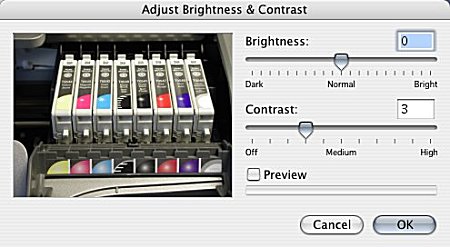 |
| Adjusting Brightness & Contrast ... and a dialog box pops up |
Select a tool and another window pops up, with any necessary controls, to let you complete the edit. Very simple, easy, effective.
SCRIPTING | Back to Contents
MediaPro has extensive AppleScript support but Windows users will have to wait a bit more for Visual Basic support. A number of AppleScripts come with the Mac version, which includes a Scripts menu option. In addition, MediaPro plays nicely with other applications, integrating itself to the extent you need and no more.
CONCLUSION | Back to Contents
Sometimes we feel like a knight errant trying to find the perfect cataloging program while image editing software adds their features behind our back. But even Photoshop CD's File Browser could learn a few tricks from MediaPro. It's been honed by battle against real demons and doesn't require seminars, tutorials and videos to appreciate.
It isn't perfect. There are some issues with Canon Raw files (why did Canon name some with a .TIF extension?) and catalogs greater than 16,895 images (but that's a bug to be fixed in the next release).
But we like it. We like that it's a standalone rather than integrated tool that lets us do a few things we have to do without imposing a certain world view on us. For a long time, we used it solely to rotate images and run slide shows and it didn't complain. Then we used it to make HTML galleries. Now we use it to distribute collections of images with a cross-platform reader that can sort, find and show the pictures. And now that we've harnessed ImageMagick to AppleScript and Perl on Mac OS X, we like that we can add our new tools to it, too.
MediaPro does a lot of little things right. Don't be surprised if this useful tool starts to grow on you. As a very clever person once put it, "Wow, this is cool!"